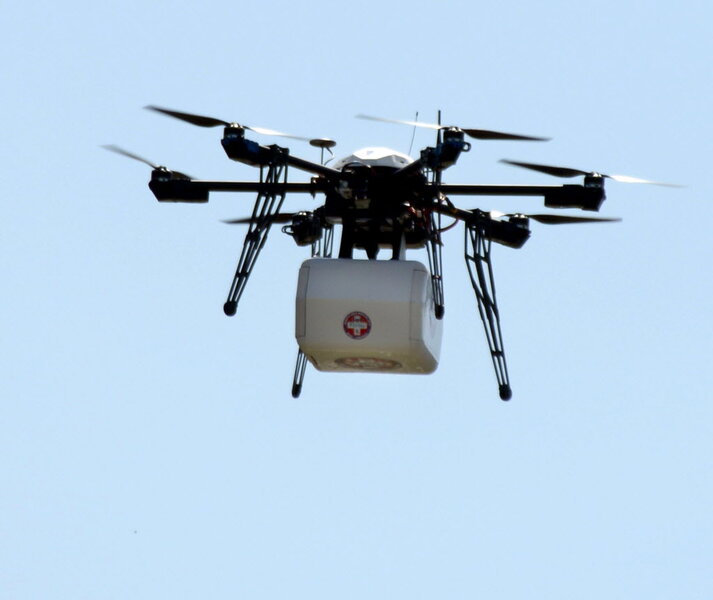Will Amazon's new plan make commercial drone use widespread?
Loading...
E-commerce giant Amazon wants to carve out a commercial space above our heads that buzzing, high-tech drones can use to deliver goods at record speed.
At the NASA UTM convention in California on Tuesday, the online retailer unveiled its proposal for Amazon Prime Air, which would designate between 200 to 400 feet of air space for “high speed transit” and “well equipped vehicles,” including unmanned aerial vehicles set to deliver Amazon orders. The proposal is part of a corporate push to normalize commercial drone use as the Federal Aviation Authority’s regulations for commercial drones fail to adapt quickly enough for most companies’ tastes. As the United States falls behind other countries in its willingness to permit the use of commercial drones, it’s essential that companies like Amazon present their own ideas for regulation, drone advocates say.
“What I hear most often is that we are way behind other countries and the lawmakers are furious,” says Michael Drobac, executive director of the Small UAV [Unmanned Aerial Vehicle] Coalition.
“It’s essential that companies like Amazon create their own proposals, and I hope that today [in the NASA UTM Convention] we hear something from Dave Vos of Google that is consistent with, or a variation of, things that we’ve heard from other companies," he adds. "The reality is it’s imperative that we hear from companies like Google, Intel, Qualcomm, and Amazon, because they are the ones with the engineers who know how to solve problems."
Amazon says that as commercial drone use becomes more common, airspace regulation for these unmanned aerial vehicles is necessary.
"In the United States, there are approximately 85,000 commercial, cargo, military and general aviation flights every day," Amazon said during the presentation. "This number is likely to be dwarfed by low altitude [unmanned drone] operations in the next 10 years."
The company’s proposal builds on NASA’s efforts to create a drone air-traffic system, known as the Unmanned Aerial System Traffic Management. The plan would allow faster, long-range drones to fly between 200 and 400 feet, while short-range drones would fly below 200 feet. Every drone would be required to have its own flight plan and maintain Internet connection, similar to the methods currently used by commercial airlines to avoid collision. Amazon also proposes that a central computer system hold all of the drones’ flight plans and location data so that participating companies can access it freely.
“Like Google, Amazon believes there doesn’t need to be a single air-traffic operator for drones. So long as the data showing where drones are flying is sent to the central computer system, any company should be allowed to participate,” Gur Kimchi, an Amazon vice president who heads the company’s drone-delivery division, told Bloomberg Business.
Organizing airspace this way would take into account the different capabilities of recreational drones, which are being flown by a constantly growing group of hobbyists, and more advanced UAVs like the kind Amazon wishes to use for delivery, company representatives argue. It would also ensure that drones don’t collide with the manned aircrafts flying at higher altitudes. The technology, Amazon says, is already ready for such a plan to be implemented.
But despite the scope of the drone airspace plan, the use of commercial drones is still in its infancy. The Federal Aviation Association only began granting permission to private companies to test drones in February 2015. According to the new rules, which have yet to be finalized, unmanned vehicles are only permitted to climb 400 feet and must remain within the pilot’s line of sight.
The FAA was expected to finalize its drone rules by September, but it is now widely understood that it will not meet that deadline. Meanwhile, Amazon and other commercial drone advocates have complained that the FAA-imposed 400-feet limitation and the requirement that drones only be flown during the day and within sight of the operator are unnecessary hindrances to business. They also say that permits for these limited flights are still too difficult to obtain.
“The problem we face in the United States is that the knee-jerk reaction from regulators has always been ‘no,’ and they’ve made the exemption process extremely arduous,” says Mr. Drobac.
“The industry is iterating at a faster pace that the government can keep up with… Only 800 companies have been granted exemptions [to fly] and thousands of companies are still waiting for approval. Each company has to go through the same process, even though they are doing something that is not very different from another company. And the process takes three to four months. There are a number of companies’ petitions that are overdue,” he adds.
While this debate is ongoing, however, some drone enthusiasts have voiced concerns that a plan like Amazon’s could place restrictions on or exclude hobbyists.
Furthermore, some experts are skeptical that commercial drone use is either imminent or desirable.
“I’m just trying to imagine what the sky is going to look like when you have Amazon drones flying around bringing people books and computer parts, and you’ve got pizza delivery companies delivering pizzas, and you have grocery stores delivering orders. It’s just a little bit hard to imagine how this is going to work in the end,” says Richard Whittle, Global Fellow at the Wilson Center and author of the book "Predator: the Secret Origins of the Drone Revolution."
“There are lots of good uses for drones that will come to pass: using them for inspections, for law enforcement, for agriculture, for delivering medicine to isolated areas. Those sorts of things clearly will be of great benefit to society. I’m not sure how important it is to get even the books that I write delivered by drone,” he adds.
Nevertheless, most experts agree that the FAA will probably take Amazon’s proposal seriously, and some have speculated that federal regulations on the use of commercial drones could be adopted in the coming year.








